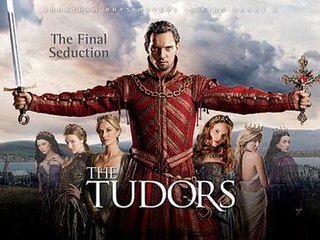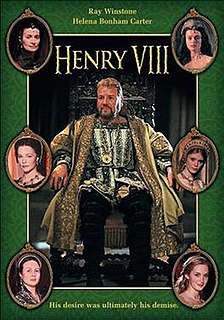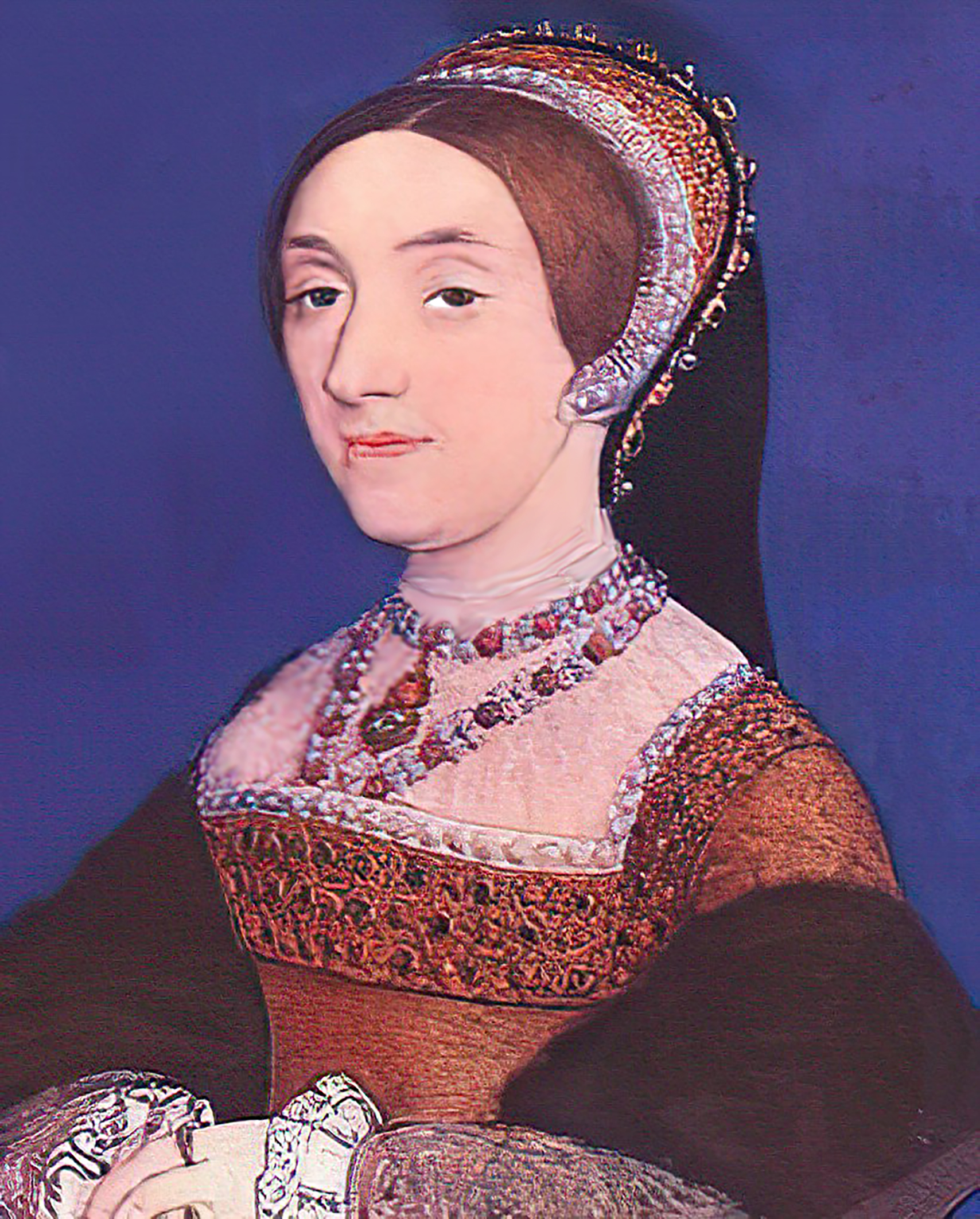
Catherine of Aragon was Queen of England from June 1509 until May 1533 as the first wife of King Henry VIII; she was previously Princess of Wales as the wife of Henry's elder brother, Arthur.

Henry VIII was King of England from 1509 until his death in 1547. Henry is best known for his six marriages, and, in particular, his efforts to have his first marriage annulled. His disagreement with Pope Clement VII on the question of such an annulment led Henry to initiate the English Reformation, separating the Church of England from papal authority. He appointed himself Supreme Head of the Church of England and dissolved convents and monasteries, for which he was excommunicated. Henry is also known as "the father of the Royal Navy," as he invested heavily in the navy, increasing its size from a few to more than 50 ships, and established the Navy Board.

Anne Boleyn was Queen of England from 1533 to 1536 as the second wife of King Henry VIII. Their marriage, and her execution for treason and other charges by beheading, made her a key figure in the political and religious upheaval that marked the start of the English Reformation. Anne was the daughter of Thomas Boleyn, 1st Earl of Wiltshire, and his wife, Lady Elizabeth Howard, and was educated in the Netherlands and France, largely as a maid of honour to Queen Claude of France. Anne returned to England in early 1522, to marry her Irish cousin James Butler, 9th Earl of Ormond; the marriage plans were broken off, and instead she secured a post at court as maid of honour to Henry VIII's wife, Catherine of Aragon.

Anne of the Thousand Days is a 1969 British period drama film based on the life of Anne Boleyn, directed by Charles Jarrott and produced by Hal B. Wallis. The screenplay by Bridget Boland and John Hale is an adaptation of the 1948 play of the same name by Maxwell Anderson.

Thomas Cromwell, 1st Earl of Essex, was an English lawyer and statesman who served as chief minister to King Henry VIII from 1534 to 1540, when he was beheaded on orders of the king.
The Six Wives of Henry VIII is a series of six television plays produced by the BBC and first transmitted between 1 January and 5 February 1970. The series was later aired in the United States on CBS from 1 August to 5 September 1971 with narration added by Anthony Quayle. The series was rebroadcast in the United States without commercials on PBS as part of its Masterpiece Theatre series.

Thomas Howard, 3rd Duke of Norfolk, was a prominent English politician and nobleman of the Tudor era. He was an uncle of two of the wives of King Henry VIII, namely Anne Boleyn and Catherine Howard, both of whom were beheaded, and played a major role in the machinations affecting these royal marriages. After falling from favour in 1546, he was stripped of his Dukedom and imprisoned in the Tower of London, avoiding execution when Henry VIII died on 28 January 1547.

Elizabeth Seymour was a younger daughter of Sir John Seymour of Wulfhall, Wiltshire and Margery Wentworth. Elizabeth and her sister Jane served in the household of Anne Boleyn, the second wife of Henry VIII. In his quest for a male heir, the king had divorced his first wife, Catherine of Aragon, whose only surviving child was a daughter, Mary. His marriage to Anne Boleyn had also resulted in a single daughter, Elizabeth. The queen's miscarriage of a son in January 1536 sealed her fate. The king, convinced that Anne could never give him male children, increasingly infatuated with Jane Seymour, and encouraged by the queen's enemies, was determined to replace her. The Seymours rose to prominence after the king's attention turned to Jane.

In common parlance, the wives of Henry VIII were the six queens consort wedded to Henry between 1509 and his death in 1547. In legal terms, King Henry VIII of England had only three wives, because three of his marriages were annulled by the Church of England. However, he was never granted an annulment by the Pope, as he desired, for Catherine of Aragon, his first wife. Annulments declare that a true marriage never took place, unlike a divorce, in which a married couple end their union. Along with his six wives, Henry took several mistresses.
Margaret Bryan, Baroness Bryan was lady governess to the children of King Henry VIII of England, the future monarchs Mary I, Elizabeth I, and Edward VI, as well as the illegitimate Henry FitzRoy. The position of lady governess in her day resembled less that of the popular modern idea of a governess, more that of a nanny.

The Tudors is a historical fiction television series set primarily in 16th-century England, created and written by Michael Hirst and produced for the American premium cable television channel Showtime. The series was a collaboration among American, British, and Canadian producers, and was filmed mostly in Ireland. It is named after the Tudor dynasty as a whole, although it is based specifically upon the reign of King Henry VIII.

Henry VIII is a two-part British television serial produced principally by Granada Television for ITV from 12 to 19 October 2003. It chronicles the life of Henry VIII of England from the disintegration of his first marriage to an aging Spanish princess until his death following a stroke in 1547, by which time he had married for the sixth time. Additional production funding was provided by WGBH Boston, Powercorp and the Australian Broadcasting Corporation.

Henry VIII and His Six Wives is a 1972 British historical film adaptation, directed by Waris Hussein, of the BBC 1970 six-part miniseries The Six Wives of Henry VIII. Keith Michell, who plays Henry VIII in the TV series, also portrays the king in the film. His six wives are portrayed by different actresses, among them Frances Cuka as Catherine of Aragon, and Jane Asher as Jane Seymour. Donald Pleasence portrays Thomas Cromwell and Bernard Hepton portrays Archbishop Thomas Cranmer, a role he had also played in the miniseries and briefly in its follow-up Elizabeth R.

The Six Wives of Henry VIII is a 2001 television documentary series about the wives of King Henry VIII presented by historian David Starkey from historic locations with added re-enactments.

Murder Most Royal (1949) is an historical fiction novel by Jean Plaidy.
Anne Berkeley, Baroness Berkeley was a lady-in-waiting and companion of Queen Anne Boleyn, the second wife of Henry VIII of England. She was one of the witnesses at the secret wedding ceremony of the King and Anne Boleyn which occurred on 25 January 1533.

Mary Boleyn, also known as Lady Mary, was the sister of English queen consort Anne Boleyn, whose family enjoyed considerable influence during the reign of King Henry VIII.

Catherine Howard was Queen of England from 1540 until 1541 as the fifth wife of Henry VIII. She was the daughter of Lord Edmund Howard and Joyce Culpeper, cousin to Anne Boleyn, and niece to Thomas Howard, 3rd Duke of Norfolk. Thomas Howard was a prominent politician at Henry's court, and he secured her a place in the household of Henry's fourth wife, Anne of Cleves, where she caught the King's interest. She married him on 28 July 1540 at Oatlands Palace in Surrey, just 19 days after the annulment of his marriage to Anne. He was 49, and she was still a teenager, at about 17 years old.
"Three Card Trick" is the first episode of the BBC Two series Wolf Hall. It was first broadcast on 21 January 2015.

Catherine of Aragon was Queen of England from June 1509 until May 1533 as the first wife of King Henry VIII. She has been portrayed in film, television, plays, novels, songs, poems, and other creative forms many times, and as a result, she has stayed very much in popular memory.